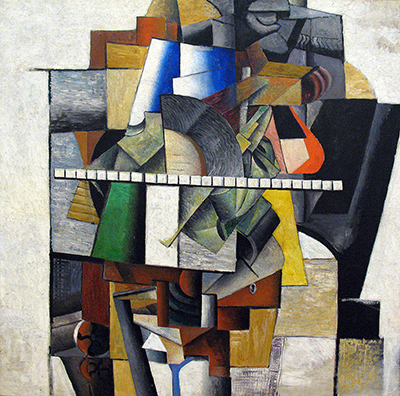Portrait of Mikhail Matyushin is a 1913 abstract artwork by Kazimir Malevich. He would work in this style several times across that year, also giving us the likes of Lamp, Musical Instruments.
There were many different techniques used within the Cubist movement, with this approach being entirely familiar. We find a standard portrait fragmented, with elements moved around in a way which makes it hard to actually identify what the artist was looking at in reality. Once we discover the title of Portrait of Mikhail Matyushin, we immediately start to look for elements of this individual to try to piece together the elements of the painting. There is a corner of his head immediately in front of us, with a smart haircut and wrinkled forehead. Around that piece, though, is a series of shaded shapes that seem completely unrelated. What is likely to have happened here is that Malevich has merged elements of the portrait and the background behind together, in a way that our own minds are untrained and therefore unable to distinguish the different parts of the painting effectively.
In order to avoid the portrait being too much for the viewer to bear, this busy composition makes use of a number of underplayed tones such as off-white, grey and light brown which helps to provide some balance to the other brighter parts. The artist would have to have planned this artwork with drawings first as the complexity would be impossible to amend extensively directly on the canvas if he had changed his mind. That said, there would have been a broad layout, but still room for expression within the final painting. The palette here is fairly wide, with brighter tones including blue, yellow and red. Some of the curved gradients might remind some of the work of artists like Fernand Leger, whose own famous paintings included the likes of Contrast of Forms, Soldiers Playing Cards and Woman with a Book. Many others were involved in the Cubist movement, but different strands appeared over time within the overall umbrella term.
This painting can be found in the Tretyakov Gallery in Moscow, Russia. The city itself serves famous Russian art particularly well and is an excellent location from which to learn more about the different movements in which this nation was involved. Although Malevich suffered from victimisation from ruling powers during his own lifetime, he is now entirely accepted and much loved within his native Russia, as it is known today. This particular gallery has many thousands of items to pick from, and so must make touch decisions over which bits to put out on display. Some of the other highlights within their collection include Kasimir Malevich's Black Square, Vasily Surikov's The Morning of the Streltsy Execution and also Ivan Shishkin and Konstantin Savitsky's Morning in a Pine Forest.




